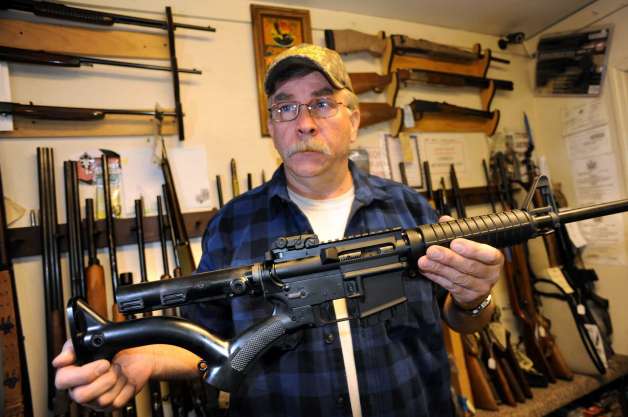Gun design legal, deadly Arms makers work to make AR-15-style weapon conform to NY SAFE Act
It might be the most divisive element of Gov. Andrew Cuomo’s NY SAFE Act: an expanded ban on what the administration terms “assault-style” weapons, such as the Vietnam-era AR-15s that are wildly popular with gun enthusiasts.
But the ban is proving to be less than total. Gun dealers, with the help of machine shops and gunsmiths, are on the cusp of offering what they call NY SAFE-compliant AR-15s and other military-style rifles.
Prototypes for the new rifles have been on display at gun shops from western New York to the Adirondacks in recent weeks. And now a lawyer representing one shop says he has gotten what amounts to an OK from the state, in the form of a letter from a State Police lawyer confirming that AR-15-style guns should be legal as long as they lack the characteristics prohibited by the law.

“It’s basically an AR-15 without the features,” said James Tresmond, a western New York lawyer representing H&H Firearms in New York, a Lackawanna gun shop that’s seeking to sell such a rifle.
“People are champing at the bit” for the modified rifle, said Justin Reickart, who with his wife operates H&H Firearms in New York.
He aims to offer an AR-15-style rifle with the pistol grip permanently removed, and without banned accessories such as a folding stock, a flash suppressor or a bayonet lug.
Thanks to modifications by a Texas-based machine shop, the stripped-down rifle has an adapter that connects the spot where the grip would go to the stock, or portion of the rifle that the shooter braces against her shoulder.
A prototype of the rifle looks almost indistinguishable from the totemic AR-15 except for the stock.
“It looks like a paintball gun,” Reickart joked.
It retains the semi-automatic capability possessed by any standard AR-15, meaning one can simply pull the trigger for each shot rather than having to work a bolt action or lever each time.
And it uses the same .223 cartridge as its military cousin.
Salespeople are showing a similar prototype rifle to customers at The Gun Shop at MacGregor’s in Lake Luzerne.
Salesman Ed Proctor said shooting enthusiasts who patronize the store, including a few state troopers, say they’re interested in buying the modified weapons.
Tresmond, Reickart, Proctor and others have stumbled upon an obvious aspect of the NY SAFE Act: The now-banned weapons are defined by a handful of very specific military-style features.
If you remove those features permanently, the guns can be made legal for purchase. (Those who owned such guns prior to the law’s implementation are grandfathered in, but they now have to register the guns with State Police.)
Lawmakers and others who opposed the law say it’s an example of how economics, along with a bit of imagination and tinkering, are prevailing over what they see as a hastily crafted law.
“The industry is starting to respond to the market,” said Rochester-area Republican Assemblyman Bill Nojay, a vocal opponent.
Nojay said the ease of modification came up during the brief legislative debate on the bill in early January.
“What the heck is the difference?” asked Troy-area GOP Assemblyman Steve McLaughlin, noting that the modified rifles have the same firepower and potential lethality as those that are banned.
Like other opponents of the law, McLaughlin said the key component of any weapon is the person behind the trigger.
Passed on the outset of this year’s legislative session, the NY SAFE Act also limited to seven the amount of cartridges that someone is allowed to put in a weapon’s magazine. The bill also requires mental health workers to report gun owners who may pose a danger to themselves or others, and it tightened rules on background checks and pistol registration. The measure was championed by Cuomo in response to the Dec. 14 mass shootings in Newtown, Conn., and the murder only days later of two firefighters outside Rochester.
The act has already sparked several lawsuits, including one by Tresmond challenging the expansion of the assault-style rifle ban.
While the legal action is likely to go on for months or years, Tresmond said he was seeking to help his gun shop client determine what he could or couldn’t sell.
He wrote to Kevin Bruen, a State Police lawyer, who affirmed that guns with the banned features permanently removed should be allowed under the new law.
“We’re moving close and closer to where we need to be for our clients,” Tresmond said.
The modifications aren’t particularly difficult for gunsmiths, who also point out that the AR-15-style rifle, first developed for military use in the late 1950s, has a modular design that makes it easy to add or remove different features.
Some gun-control advocates said the developing market for NY SAFE-compliant rifles was news to them, but not a surprise.
Long Island Democratic Assemblywoman Michelle Schimel said that following the 1994 federal assault weapons ban — which expired a decade later — gunmakers developed “AB” or “After-Ban” models of military-style weapons.
Schimel disagreed with McLaughlin on the significance of the modifications. She said the banned features, including pistol grips, are designed to increase a weapon’s effectiveness, or killing power.
“A pistol grip helps you keep firing on a target,” she said. “Each characteristic has a specific battle component.”
Manhattan Democratic Assemblyman Brian Kavanagh, another gun control advocate, made a similar point about a firearm’s form versus function.
“The bill does not talk about whether a gun looks scary,” he said. “The bill talks about specific characteristics.”
But the ban is proving to be less than total. Gun dealers, with the help of machine shops and gunsmiths, are on the cusp of offering what they call NY SAFE-compliant AR-15s and other military-style rifles.
Prototypes for the new rifles have been on display at gun shops from western New York to the Adirondacks in recent weeks. And now a lawyer representing one shop says he has gotten what amounts to an OK from the state, in the form of a letter from a State Police lawyer confirming that AR-15-style guns should be legal as long as they lack the characteristics prohibited by the law.

“It’s basically an AR-15 without the features,” said James Tresmond, a western New York lawyer representing H&H Firearms in New York, a Lackawanna gun shop that’s seeking to sell such a rifle.
“People are champing at the bit” for the modified rifle, said Justin Reickart, who with his wife operates H&H Firearms in New York.
He aims to offer an AR-15-style rifle with the pistol grip permanently removed, and without banned accessories such as a folding stock, a flash suppressor or a bayonet lug.
Thanks to modifications by a Texas-based machine shop, the stripped-down rifle has an adapter that connects the spot where the grip would go to the stock, or portion of the rifle that the shooter braces against her shoulder.
A prototype of the rifle looks almost indistinguishable from the totemic AR-15 except for the stock.
“It looks like a paintball gun,” Reickart joked.
It retains the semi-automatic capability possessed by any standard AR-15, meaning one can simply pull the trigger for each shot rather than having to work a bolt action or lever each time.
And it uses the same .223 cartridge as its military cousin.
Salespeople are showing a similar prototype rifle to customers at The Gun Shop at MacGregor’s in Lake Luzerne.
Salesman Ed Proctor said shooting enthusiasts who patronize the store, including a few state troopers, say they’re interested in buying the modified weapons.
Tresmond, Reickart, Proctor and others have stumbled upon an obvious aspect of the NY SAFE Act: The now-banned weapons are defined by a handful of very specific military-style features.
If you remove those features permanently, the guns can be made legal for purchase. (Those who owned such guns prior to the law’s implementation are grandfathered in, but they now have to register the guns with State Police.)
Lawmakers and others who opposed the law say it’s an example of how economics, along with a bit of imagination and tinkering, are prevailing over what they see as a hastily crafted law.
“The industry is starting to respond to the market,” said Rochester-area Republican Assemblyman Bill Nojay, a vocal opponent.
Nojay said the ease of modification came up during the brief legislative debate on the bill in early January.
“What the heck is the difference?” asked Troy-area GOP Assemblyman Steve McLaughlin, noting that the modified rifles have the same firepower and potential lethality as those that are banned.
Like other opponents of the law, McLaughlin said the key component of any weapon is the person behind the trigger.
Passed on the outset of this year’s legislative session, the NY SAFE Act also limited to seven the amount of cartridges that someone is allowed to put in a weapon’s magazine. The bill also requires mental health workers to report gun owners who may pose a danger to themselves or others, and it tightened rules on background checks and pistol registration. The measure was championed by Cuomo in response to the Dec. 14 mass shootings in Newtown, Conn., and the murder only days later of two firefighters outside Rochester.
The act has already sparked several lawsuits, including one by Tresmond challenging the expansion of the assault-style rifle ban.
While the legal action is likely to go on for months or years, Tresmond said he was seeking to help his gun shop client determine what he could or couldn’t sell.
He wrote to Kevin Bruen, a State Police lawyer, who affirmed that guns with the banned features permanently removed should be allowed under the new law.
“We’re moving close and closer to where we need to be for our clients,” Tresmond said.
The modifications aren’t particularly difficult for gunsmiths, who also point out that the AR-15-style rifle, first developed for military use in the late 1950s, has a modular design that makes it easy to add or remove different features.
Some gun-control advocates said the developing market for NY SAFE-compliant rifles was news to them, but not a surprise.
Long Island Democratic Assemblywoman Michelle Schimel said that following the 1994 federal assault weapons ban — which expired a decade later — gunmakers developed “AB” or “After-Ban” models of military-style weapons.
Schimel disagreed with McLaughlin on the significance of the modifications. She said the banned features, including pistol grips, are designed to increase a weapon’s effectiveness, or killing power.
“A pistol grip helps you keep firing on a target,” she said. “Each characteristic has a specific battle component.”
Manhattan Democratic Assemblyman Brian Kavanagh, another gun control advocate, made a similar point about a firearm’s form versus function.
“The bill does not talk about whether a gun looks scary,” he said. “The bill talks about specific characteristics.”


